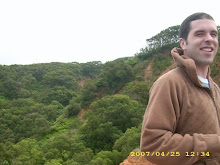
Driving east down the Trans Canada, traffic quickly emerged and disappeared through the thick pea soup fog that had enveloped south-eastern Manitoba. The day was not looking promising on the weather front. One of the main reasons we were venturing out to the Northwest Angle was to take photographs for a travel advertisement. The fog was going to put a major monkey wrench in our plans to take some blue-skied photos for our ads.
Luck was on our side that day though, as the fog began to lift as we made the hard left off the paved Trans Canada onto the chunky, ungraded gravel road to the Angle. As we made our way down the sparsely travelled rut-filled back road, the fog began to dissipate and the sun began to radiate downward onto the pristine wilderness of the Northwest Angle Provincial Forest.
After an hour and a half of witty banter, fart jokes, and Sean experiencing the joys of beef jerky for the first time, we came across the Canada-U.S. border. It was a surreal experience. In an age where the United States are cracking down hard on travel across the world's longest undefended border, the border crossing here stands as the anti-thesis to the near militarization of border crossings from the east coast to the west coast. All that marks the border here are a couple signs welcoming you to Minnesota and Manitoba, respectively, and a lone obelisk-shaped marker that stands in a clearing that runs the length of the border. There was not a single person in sight, let alone an overzealous border patrol officer.
The border crossing at the Northwest Angle is based on the honour system. A few kilometres in from the border lies Jim's Corner. That's literally all it is; a corner, where two roads intersect. All there is at this lonely intersection is a corrugated metal shack. This is border control. We entered the shack and picked up the video phone, pressing the button labeled United States. After a brisk, all business conversation with an American border officer in Warroad, we were cleared to be in the United States. No passports required, no hassles, no games of twenty questions.

We had an appointment setup to visit a lodge owner for a quick interview. Going off the vague directions that the man had given Eman, we drove aimlessly around for awhile through what appeared to be a ghost town. There was not a soul in sight. All the cottages were empty and no one was on the road. We finally arrived at the lodge office to find a sign directing us to the owners house. After getting lost again for a bit, we arrived at the house to find another sign telling visitors to check in at a different house. We ventured off to find this house, but quickly got lost and then finally gave up on the quest.
Instead we ventured off in search of the closest bar. It had become obvious that if we wanted answers about the Angle, we would likely find them at the town's bar. After a few dead ends, we arrived at Young's Bay and Jerry's Bar. The bar sits right on the edge of Lake of the Woods and is the hub off the Angle's community. Jerry's is a quaint, small town watering hole. Miniature American flags rest on every table, the walls are paneled with lacquered pine planks, and ancient Schlitz beer cans line the shelves above the bar.

Bonnie Edin was tending the bar when we arrived. The former Minneapolis resident had been drawn to this remote outpost three years earlier because of her love for the outdoors and the "raw beauty of nature." She quickly became our source for everything we needed to know about the Angle and who we should talk to if we wanted to find out more. She pointed us in the direction of the ice road that led out on to the frozen surface of Lake of the Woods, giving us the humourous advice that everyone in the Angle "drives with their seat belts off and their windows rolled down, just in case."
With her words of wisdom in mind, we drove my car out on to the lake. We must have looked so out of place. In a land of 1/2 ton trucks and snowmobiles, we were cruising around the lake in a tiny Mazda 3 sedan. We had a little bit of trouble wrapping our minds around the fact that we were driving on a lake. I had driven on the frozen Red River a few times when I was in high school; tearing it up near Lockport, pulling doughnuts and fishtails. This was completely different. We were soon in the middle of a wide channel between islands, a few kilometres off the shore. If the ice cracked, we would be royally screwed.

The ice roads around the Northwest Angle and its surrounding islands are the life blood of the community. With over ten fishing lodges off the mainland, guests and supplies are trucked across the ice from the mainland on a daily basis. Hundreds of kilometres of roads traverse the ice in the area, with the main road extending across the frozen lake north to Kenora. Hundreds of kilometres of groomed snowmobile trails criss cross these ice roads. Sleds seem to be the preferred form of transportation in the angle.

We sped off further down the ice road, further away from the relative safety of the shore. We were searching for snowmobilers and ice fishers, so we could get an idea what brings them to this remote corner of Lake of the Woods. Out on the wide open lake, surrounded by the rugged granite cliffs of Shield Country, we were beginning to understand why.
The Nub part 3, coming soon.


